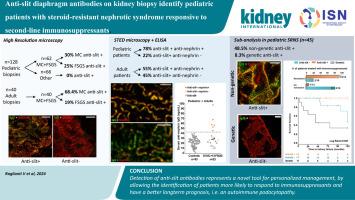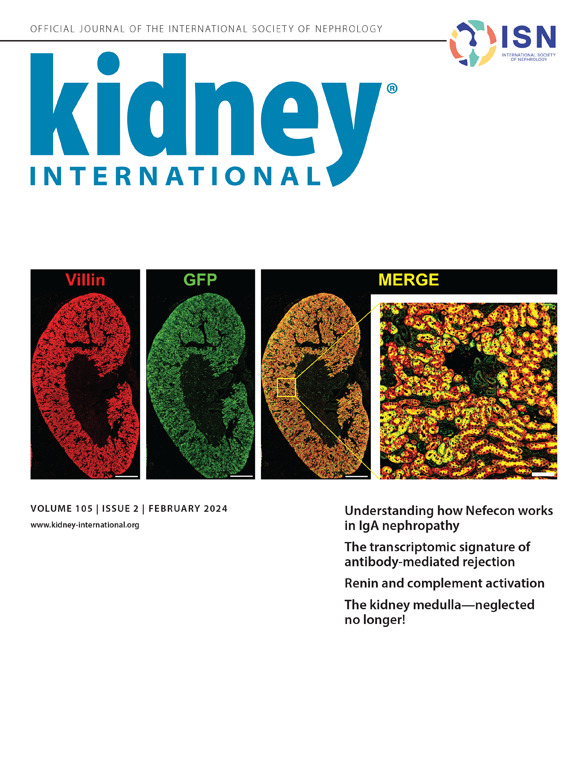Anti-slit diaphragm antibodies on kidney biopsy identify pediatric patients with steroid-resistant nephrotic syndrome responsive to second-line immunosuppressants
IF 14.8
1区 医学
Q1 UROLOGY & NEPHROLOGY
引用次数: 0
Abstract
Podocytopathies represent a group of glomerular disorders associated with minimal changes (MC) or focal segmental glomerulosclerosis (FSGS) lesion patterns at biopsy and heterogeneous responses to steroids. Anti-nephrin antibodies were previously found in such patients, suggesting an autoimmune form of podocytopathy. High resolution confocal microscopy on kidney biopsies of a cohort of 128 pediatric patients revealed localization of IgG along the slit diaphragm in 30% of patients with MC and 25% of those with FSGS, but not in other lesion patterns. Anti-nephrin IgG ELISA assay in the serum and stimulated emission depletion microscopy of kidney biopsies showed IgG-nephrin co-localization only in 77.8% of cases. Similar observations were obtained in a cohort of 48 adult patients with MC or FSGS at kidney biopsy, where IgG-nephrin colocalization was only 44.4%, suggesting the existence of autoantibodies binding to other slit proteins. Patients with anti-slit antibodies showed nephrotic syndrome at onset in 94.4% of cases. Patients with primary steroid-resistance had anti-slit antibodies in 27%, while those with secondary steroid-resistance in 87.5% of cases, irrespective of the histopathological lesion pattern. Steroid-resistant patients with anti-slit antibodies responded to second-line immunosuppressants in 92.3% vs. only 20% of patients that were anti-slit negative. No patient with anti-slit antibodies developed kidney failure vs. 51.7% of those negative for antibodies (66.7% with a genetic cause and 41.2% with a non-genetic cause). Thus, the detection of anti-slit antibodies can identify patients with an autoimmune podocytopathy responsive to treatment with second-line immunosuppressants, irrespective of the histopathological lesion pattern at biopsy.

肾活检中的抗裂隙隔膜抗体能识别对二线免疫抑制剂有反应的类固醇耐药肾病综合征儿科患者。
荚膜细胞病是一组肾小球疾病,活检时病变形态为微小病变(MC)或局灶节段性肾小球硬化(FSGS),对类固醇的反应各不相同。以前曾在这类患者中发现过抗肾上腺素抗体,这表明荚膜细胞病变是一种自身免疫形式。高分辨率共聚焦显微镜对128名儿科患者的肾活检结果显示,在30%的MC患者和25%的FSGS患者中,IgG沿着裂隙膈定位,而在其他病变模式中则没有发现。血清中的抗肾上腺素 IgG ELISA 检测和肾活检的刺激发射耗竭显微镜检查显示,只有 77.8% 的病例出现 IgG 与肾上腺素共定位。在对48名患有MC或FSGS的成年患者进行肾活检时也发现了类似的情况,IgG-肾素共定位的比例仅为44.4%,这表明存在与其他狭缝蛋白结合的自身抗体。94.4%的抗狭缝抗体患者在发病时表现为肾病综合征。原发性类固醇耐药的患者中,27%有抗狭缝抗体,而继发性类固醇耐药的患者中,87.5%有抗狭缝抗体,与组织病理学病变模式无关。有抗裂隙抗体的类固醇耐药患者中有92.3%对二线免疫抑制剂有反应,而抗裂隙抗体阴性的患者只有20%有反应。抗裂隙抗体阳性患者中没有人出现肾衰竭,而抗裂隙抗体阴性患者中有51.7%出现肾衰竭(66.7%为遗传原因,41.2%为非遗传原因)。因此,无论活检的组织病理学病变模式如何,抗裂隙抗体的检测都能发现对二线免疫抑制剂治疗有反应的自身免疫性荚膜细胞病变患者。
本文章由计算机程序翻译,如有差异,请以英文原文为准。
求助全文
约1分钟内获得全文
求助全文
来源期刊

Kidney international
医学-泌尿学与肾脏学
CiteScore
23.30
自引率
3.10%
发文量
490
审稿时长
3-6 weeks
期刊介绍:
Kidney International (KI), the official journal of the International Society of Nephrology, is led by Dr. Pierre Ronco (Paris, France) and stands as one of nephrology's most cited and esteemed publications worldwide.
KI provides exceptional benefits for both readers and authors, featuring highly cited original articles, focused reviews, cutting-edge imaging techniques, and lively discussions on controversial topics.
The journal is dedicated to kidney research, serving researchers, clinical investigators, and practicing nephrologists.
 求助内容:
求助内容: 应助结果提醒方式:
应助结果提醒方式:


